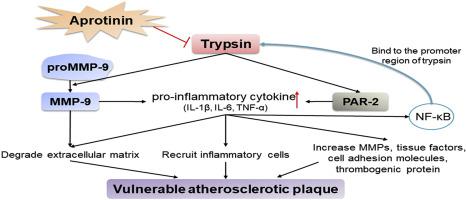Archives of Biochemistry and Biophysics ( IF 3.8 ) Pub Date : 2020-06-27 , DOI: 10.1016/j.abb.2020.108460 Jia-Yu Shi 1 , Hai-Yan Pan 1 , Kun Liu 2 , Min Pan 1 , Guo-Jun Si 3

|
Background
Our previous research revealed that trypsin is abundantly expressed in atherosclerotic plaques and its distribution overlaps with that of matrix metalloproteinase-9 (MMP-9). This study was performed to explore the possible roles of trypsin in vulnerable atherosclerotic plaque formation.
Methods and results
Twenty-four rabbits were randomly assigned to a normal (control) group, an atherosclerosis (experimental) group and a trypsin inhibitor (aprotinin) group. In the 13th feeding week, the aprotinin group was treated with 5 mg/kg/day aprotinin via ear vein for 4 weeks. At the end of the 16th week, coronary arterial and aortic expression of trypsin, proteinase-activated receptor-2 (PAR-2), activated MMP-9, and pro-inflammatory cytokines were significantly greater in the experimental group than in the control group. Aprotinin decreased trypsin expression and activation in plaques, blocked PAR-2 and MMP-9 activation, and decreased cytokine expression; it also increased fibrous cap thickness, decreased the intima-media thickness and intimal/medial ratio, thus significantly ameliorating plaque vulnerability. Upregulated trypsin, MMP-9 and PAR-2 were also found in coronary intimal atherosclerotic plaques of patients undergoing coronary artery bypass grafting.
Conclusions
Ectopic trypsin was significantly upregulated in atherosclerotic plaques, which increased pro-inflammatory cytokine levels by activating PAR-2 and promoted plaque instability by activating proMMP-9, thereby promoting atherosclerosis and plaque vulnerability. In addition, the high trypsin expression in human coronary intimal atherosclerotic plaques suggests that targeting trypsin may be a new strategy for acute coronary syndrome prevention.
中文翻译:

异位胰蛋白酶在动脉粥样硬化斑块中的表达以及抑肽酶对斑块稳定性的影响。
背景
我们以前的研究表明,胰蛋白酶在动脉粥样硬化斑块中大量表达,其分布与基质金属蛋白酶9(MMP-9)重叠。进行这项研究是为了探索胰蛋白酶在脆弱的动脉粥样硬化斑块形成中的可能作用。
方法与结果
将24只兔随机分为正常(对照组),动脉粥样硬化(实验)组和胰蛋白酶抑制剂(抑肽酶)组。在喂养的第13周,抑肽酶组经耳静脉给予5 mg / kg / day抑肽酶治疗4周。在第16周结束时,实验组的胰蛋白酶,蛋白酶激活的受体2(PAR-2),激活的MMP-9和促炎性细胞因子的冠状动脉和主动脉表达明显高于对照组。 。抑肽酶降低了胰蛋白酶在斑块中的表达和激活,阻断了PAR-2和MMP-9的激活,并降低了细胞因子的表达。它也增加了纤维帽的厚度,降低了内膜-中膜的厚度和内膜/内膜的比率,从而显着改善了斑块的脆弱性。胰蛋白酶上调,
结论
异位胰蛋白酶在动脉粥样硬化斑块中显着上调,其通过激活PAR-2增加促炎细胞因子水平,并通过激活proMMP-9促进斑块不稳定,从而促进动脉粥样硬化和斑块易损性。另外,胰蛋白酶在人冠状动脉内膜粥样硬化斑块中的高表达表明,靶向胰蛋白酶可能是预防急性冠状动脉综合征的一种新策略。











































 京公网安备 11010802027423号
京公网安备 11010802027423号